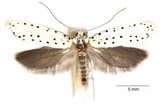Yponomeuta cagnagella (Hübner, [1813]) Species
Last modified: Dec. 10, 2025, 12:20 p.m.
A common species in Belgium wherever the food plants grows.
Details
- Classification
- Family: Yponomeutidae > Subfamily: Yponomeutinae > Genus: Yponomeuta > Species: Yponomeuta cagnagella
- Vernacular names
- Kardinaalsmutsstippelmot (NL), Spindle Ermine (EN), Grand Yponomeute du Fusain, l'Yponomeute parente (FR), Pfaffenhütchen-Gespinstmotte (DE)
- Synonyms
- Yponomeuta cognatella (Hübner, 1825)
- First mention in Belgium
- De Sélys-Longchamps E. 1844. Énumération des insectes Lépidoptères de la Belgique. — Mémoires de la Société royale des Sciences de Liége 2: 1–35. On page 23 (as Yponomeuta cognatella H.). view page
- Status
-
Native
Distribution
Imago
The wingspan of this white moth with black dots ranges from 18 to 26 mm. It is hardly distinguishable from the other members in its genus. In this case, even microscopic investigation of the genitals does not allow a certain identification.
Specimens of Yponomeuta cagnagella, Y. malinellus and Y. padella can in many cases not be identified beyond doubt either by external characteristics or by genital differences and even less by photos of living moths. Knowledge of the caterpillar host plant is indispensable.
Egg
The flattened eggs are deposited in heaps (20 to 50 close together) on the host plant and are covered with a gel-like layer.
Caterpillar
Three Belgian species Yponomeuta live on the host plant Euonymus.
Caterpillars of Yponomeuta cagnagella and Yponomeuta irrorella are very difficult to distinguish.
In contrast to the caterpillars of Y. cagnagella which live socially in a web, Yponomeuta irrorella caterpillars live individually in a web.
The caterpillars of the third species Yponomeuta plumbella are easy to distinguish from the other 2 species.
Cocoon/pupa
The cocoon is tough, hard and white. The pupa is brown.
Bionomics
The eggs are deposited in heaps, containing 20 to 50 eggs, on branches of the hostplant and close to a bud. The female covers the eggs with a gel-like layer. Inside the eggs, the small caterpillars already develop in late summer and hibernate under their eggshells. In springtime, they eat their way in the young buds and, later on, spin young leaves together and make small blotch mines in them. These infested shoots and young leaves often go limp early. But soon, the caterpillars leave their mines and start to construct the well-known communal webs that can cover entire bushes wherein the caterpillars live gregariously together to feed on the leaves of the hostplant. Eventually, the pupation occurs, often arranged side by side, near the bottom of the web in a hard and white cocoon.
The adults are attracted to light.
Flight periods
One generation a year from mid-June till the end of August.
Observed on
- Host plant (species):
- Euonymus europaeus and Euonymus japonica
The larvae feed monophagously on the leaves of Euonymus spp. and especially Euonymus europaeus.














